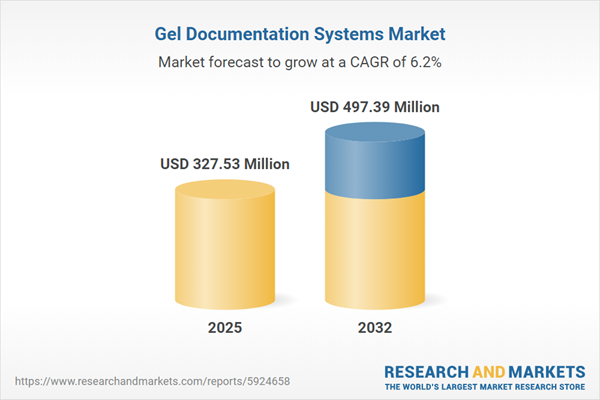Speak directly to the analyst to clarify any post sales queries you may have.
Gel documentation systems are transforming laboratory operations by supporting precise imaging, efficient workflows, and elevated compliance standards. As digital strategies reshape the scientific and healthcare landscape, these systems offer laboratories a scalable advantage for strengthening research quality and regulatory alignment.
Market Snapshot: Gel Documentation Systems Market Growth and Outlook
The global gel documentation systems market is experiencing consistent growth, reaching a value of USD 308.30 million in 2024, with projections of USD 327.53 million for 2025 and an anticipated expansion to USD 497.39 million by 2032. This trajectory represents a compound annual growth rate of 6.16%.
Key drivers fueling this momentum include increased investments in laboratory automation, greater emphasis on digital processes, and the wide-ranging adoption of gel documentation solutions across academic, pharmaceutical, biotechnology, and diagnostic settings. Enhanced imaging accuracy, integrated data analysis, and streamlined operational workflows are making these systems indispensable for meeting evolving laboratory needs.Scope & Segmentation of the Gel Documentation Systems Market
This report offers a targeted evaluation of the major segments and influencing factors within the gel documentation systems market, enabling executive stakeholders to align technology investments with organizational goals. Segmentation provides detailed perspectives across core industry categories and their significance for buyers:
- Product Types: Multi-purpose imaging platforms, standalone imaging units, UV and white light transilluminators, chemiluminescence and fluorescence solutions, as well as systems intended for both manual and automated use. Modular and fixed designs let laboratories address standard assays or advanced analytical procedures with flexibility.
- Applications: Relevant for academic research, therapeutic development, molecular diagnostics, forensic analysis, genomics, proteomics, and regulatory compliance initiatives. This variety reflects the importance of adaptable and compliant imaging systems for core laboratory operations.
- End Users: Universities, private research institutes, hospitals, clinical and diagnostics laboratories, as well as pharmaceutical manufacturers. These groups seek robust, workflow-optimized solutions that reinforce compliance across distinct research environments.
- Technologies: Solutions leverage high-resolution CCD and advanced CMOS image sensors. Options include both back-illuminated and front-illuminated sensor variants, supporting precise, reproducible data capture for a wide range of laboratory procedures.
- Geographies: The report considers adoption trends and procurement practices across the Americas, Europe, Asia-Pacific, Middle East, and Africa. Insights into regional regulatory frameworks and sourcing patterns help identify localized growth opportunities and operational risks.
Gel Documentation Systems: Key Takeaways for Strategic Decision-Makers
- Modular and automated gel documentation solutions empower laboratories to reallocate resources flexibly, ensuring operational agility as research and compliance requirements progress.
- Integration with IoT and cloud-based platforms enhances data oversight, allowing real-time collaboration among globally distributed teams and safeguarding sensitive research data.
- Direct connectivity with laboratory information management systems (LIMS) strengthens traceability across sample workflows and streamlines compliance documentation processes.
- Machine learning capabilities support consistent imaging practices, minimize result variability, and advance reproducibility for high-value research outcomes.
- Scalable solution architectures future-proof laboratory investments, supporting both modernization initiatives in legacy facilities and expansion in new build-outs.
- Strategic partnerships with technology vendors, including predictive maintenance and targeted staff training, enhance equipment uptime and ensure business continuity.
Tariff Impact: Navigating Supply Chain and Procurement Pressures
Revisions to US tariffs prompt manufacturers and suppliers of gel documentation systems to reassess sourcing and stock management. Procurement leaders now diversify supply sources and elevate inventory reserves to counteract shifting lead times and component availability. These strategies foster process continuity and mitigate the effects of potential regulatory disruptions, supporting uninterrupted laboratory operations as global market conditions evolve.
Methodology & Data Sources
Research findings in this report derive from a combination of qualitative and quantitative methods, including technical evaluations, regulatory scrutiny, and contributions from subject matter authorities. Data points are cross-validated with multiple market analyses and verified stakeholder feedback, ensuring a high standard of accuracy and consistency.
Why This Gel Documentation Systems Market Report Matters
- Equips senior executives with clear guidance for directing technology investments that match laboratory and organizational needs worldwide.
- Provides procurement leaders with practical frameworks to reinforce supply chains and handle evolving sourcing scenarios.
- Assists laboratory managers in deploying automation and digital solutions that strengthen preparedness, efficiency, and compliance in regulated environments.
Conclusion
Gel documentation systems support future-ready laboratory operations and regulatory alignment. This report offers top-level stakeholders actionable insights for confident decision-making in an advancing market.
Additional Product Information:
- Purchase of this report includes 1 year online access with quarterly updates.
- This report can be updated on request. Please contact our Customer Experience team using the Ask a Question widget on our website.
Table of Contents
3. Executive Summary
4. Market Overview
7. Cumulative Impact of Artificial Intelligence 2025
Companies Mentioned
The companies profiled in this Gel Documentation Systems market report include:- Bio-Rad Laboratories, Inc.
- Thermo Fisher Scientific Inc.
- Cytiva UK Limited
- LI-COR Biosciences, Inc.
- Analytik Jena AG
- Syngene International Limited
- Vilber Lourmat SAS
- Azure Biosystems, Inc.
- ProteinSimple, Inc.
- Bio-Cam S.r.l.
Table Information
| Report Attribute | Details |
|---|---|
| No. of Pages | 186 |
| Published | November 2025 |
| Forecast Period | 2025 - 2032 |
| Estimated Market Value ( USD | $ 327.53 Million |
| Forecasted Market Value ( USD | $ 497.39 Million |
| Compound Annual Growth Rate | 6.1% |
| Regions Covered | Global |
| No. of Companies Mentioned | 11 |









